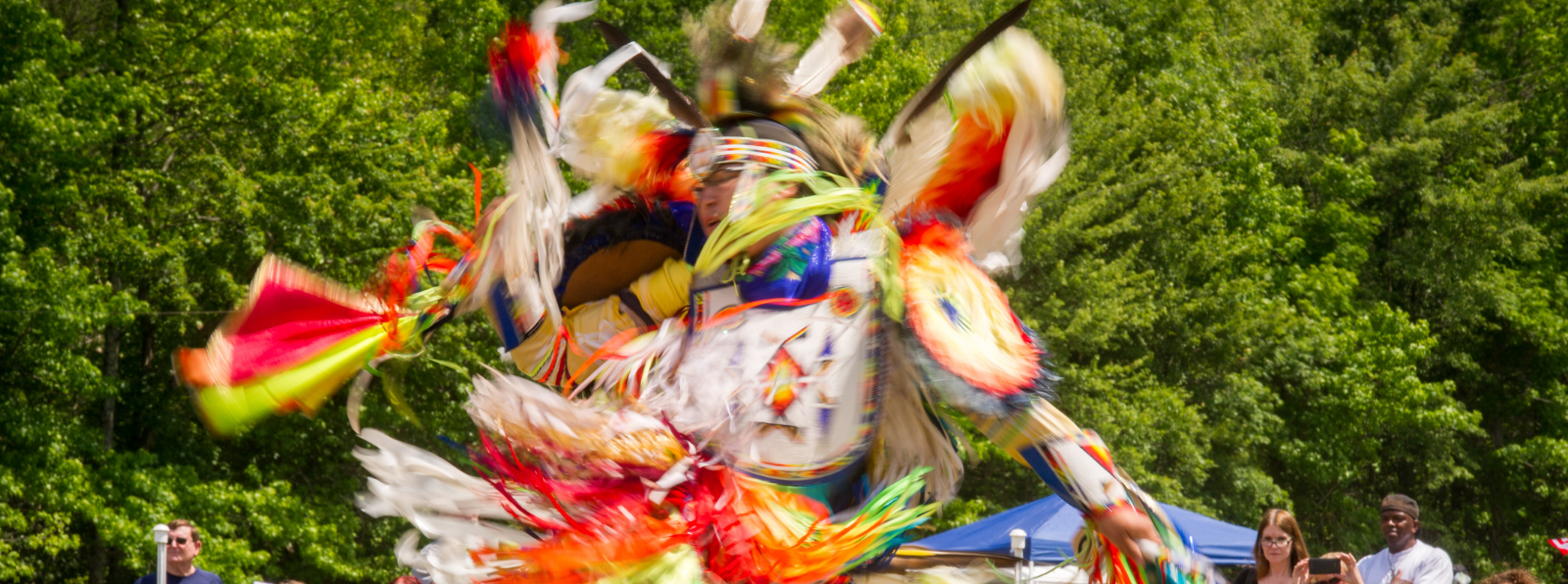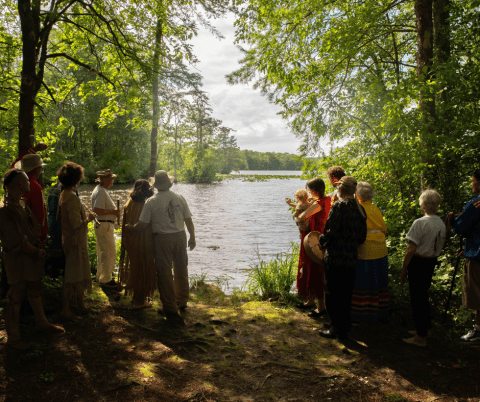A land acknowledgement statement can be a powerful starting place. Use the process of creating and delivering land acknowledgements to learn more about Indigenous peoples, history, and culture, and to work towards positive change led by Indigenous peoples.
Click here to view the MSAC Land Acknowledgement Project Overview and Resource Guide. This guide features best practices, tribal histories and maps, and land acknowledgement statements. It also includes a “Key Concepts” section containing culturally-specific information to help constituents more easily create land acknowledgements. Tribal consultants have reviewed the document for cultural accuracy and approved it.
Introduction to Land Acknowledgements
Land acknowledgments are statements that recognize Indigenous peoples dispossessed of their relationships with land by settler colonists. These statements bring attention to the Indigenous peoples who are (and/or were once) local to the lands that settler colonists and settler colonial institutions currently occupy. Indigenous erasure, the set of processes that remove Indigenous people from places and narratives, has been exceedingly prevalent in the mid-Atlantic region for much of the past 500 years. Despite still living in the region, most tribal peoples are “disappeared” into the history books and are associated only with their colonial histories. Land acknowledgment statements are a minor way to acknowledge Indigenous sovereignty and correct the inaccurate impression that Native peoples no longer exist in Maryland.
There are many ways to create and deliver land acknowledgments, including speaking the acknowledgment at the beginning of an event, placing it in program notes, publishing it in publicly visible spaces, or posting it online. The webinar linked below, hosted in 2020 by Maryland Traditions staff, provides an introduction to land acknowledgments and a guide on how to create them.
Click here to view the “Land Acknowledgement in Context” webinar.
Land acknowledgments can too easily become performative acts that merely pay lip service and have no substance. As such, land acknowledgment statements can better function as a starting place rather than an endpoint. The webinar linked below, hosted in 2021 by Maryland Traditions staff and featuring tribal leaders and elders from lands claimed by Maryland, features recommendations on how to make the acts of creating and delivering a land acknowledgment statement the beginning of positive change. Webinar participants recommend:
- Learning about local tribal histories
- Donating to tribes on whose land you live or work
- Returning land to tribes
- Establishing Memorandums of Understanding (MOUs) or contracts with tribes so they can access land or resources owned by institutions free of charge
- Stewarding the lands you own or control -- for example, by learning about invasive and native plant and animal species and increasing biodiversity
Click here to view the “Land Acknowledgement 2.0” webinar.
Tribal Land Acknowledgement Statements
Each of the following land acknowledgment statements derive from formal, compensated consultations with tribal leaders and elders from tribes whose lands are claimed by Maryland and most of whom have or had a relationship with the Maryland Commission on Indian Affairs. View the "Resource Guide" linked in red text at the top of this page for tribal histories, maps, and key concepts.
MSAC has been unable to consult with several tribes whose lands are claimed by Maryland. Since MSAC does not want to make any statements without tribal knowledge, review, or approval, these tribes are not represented in this section. We look forward to being able to consult with them in the future. One tribe, the Cedarville Band Wild Turkey Clan of the Piscataway Conoy Tribe, declined to consult with MSAC, and requests that this "Resource Guide" include the following information: that the Band declined to engage in, and does not endorse, this MSAC Land Acknowledgement Project. Tribal leadership requests that folks learn about paying "Land Tax," giving "Land Back," and what land acknowledgment on Piscataway Conoy lands looks like to them, in their own sovereign words, by visiting their website at piscatawayIndians.com.
In some instances, two or more tribes have a history or relationship with a particular land. These histories, claims, and counterclaims are not unusual across North America and typically result from the ways colonists and colonial governments pitted tribal peoples against one another for settler gain. When creating a land acknowledgment for contested land, it is recommended to acknowledge all Indigenous communities with connections to that land and to acknowledge the role of settlers and colonial governments in causing breakdowns in the relationships between Indigenous communities, and between communities and their lands.
Created by MSAC staff based on information shared by Accohannock Indian Tribe tribal consultants.
I/we acknowledge that the Accohannock Indian Tribe continues to maintain relationships with the lands where we gather today. The Accohannock have stewarded this land for generations. I/we acknowledge their kinship to these lands and waters. I/we acknowledge that we are uninvited visitors on Indigenous lands. To make this statement more meaningful, I/we invite you to learn more about the Accohannock and about land acknowledgement statements via resources available at msac.org and elsewhere, to consider donating or making institutional resources available to tribal peoples, and to reconsider in what ways you can improve your relationship with the lands you steward.
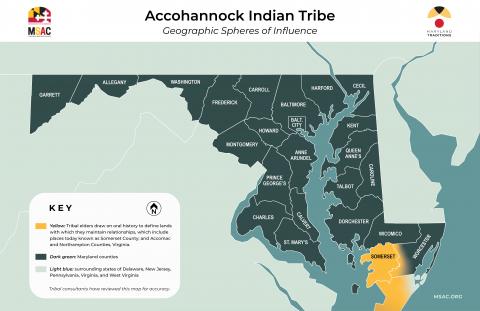
Created by MSAC staff based on information shared by Assateague People’s Tribe tribal consultants.
I/we acknowledge that the Assateague continue to maintain relationships with the lands where we gather today. The Assateague have stewarded these lands and waters for generations. Assateague peoples successfully avoided the genocide attempt upon them by Edward Scarborough in the 1650s, and later signed several treaties with the Maryland Colony. Although many tribal members moved north into Iroquoian lands in the late 1700s, some remained and continue to steward this land. We acknowledge them and their ancestors and acknowledge that we are uninvited visitors on Indigenous lands. To make this statement more meaningful, I/we invite you to learn more about the Assateague and about land acknowledgement statements via resources available at msac.org and elsewhere, to consider donating or making institutional resources available to tribal peoples, and to reconsider in what ways you can improve your relationship with the lands you steward.
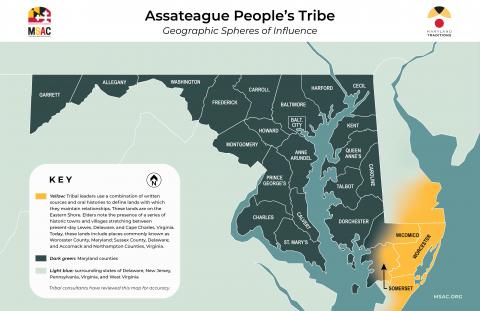
This statement was authored by Choptico elders for MSAC’s Land Acknowledgement Project.
We acknowledge the Indigenous peoples formerly occupying lands known as Choptico, land upon and beyond both banks of water now known as Wicomico, where they lived for untold centuries prior to first European colonization; and,
We acknowledge Native peoples living upon said land, who became known as Choptico Indians by the colonial government, though many natives arrived from other towns and villages to Choptico following displacement by colonists; and,
We acknowledge that those lands and waters relied upon for sustenance, housing, and other considerations, were with intent, methodically decreased to an area that became known as the Choptico Reserve, upon which they were forced to subsist and live upon; and,
We acknowledge Choptico lands were neither ceded nor sold to colonists, the colonial government of Maryland, or the United States, and not ceded by any “Just War” or Treaty; and,
We acknowledge that Choptico lands were overrun by colonists who used their laws, subtle means of indebtedness, and other acts of duress to displace the Choptico from their lands; and,
We acknowledge the graves of Choptico ancestors that were plundered for grave goods and their earthly remains removed and never repatriated for reburial: and,
We acknowledge the descendants of those displaced from the Choptico Homeland who have for more than three centuries endured forced assimilation, misidentification, intentional omission of existence, and loss of traditions, language, worldview, and lifeways, and been forced into a diasporic existence; and,
We acknowledge the Choptico Indians’ resilience in holding steadfast to their culture and identity and maintaining efforts to recover a portion of their former homeland while recovering from invasion, displacement, and oppression.
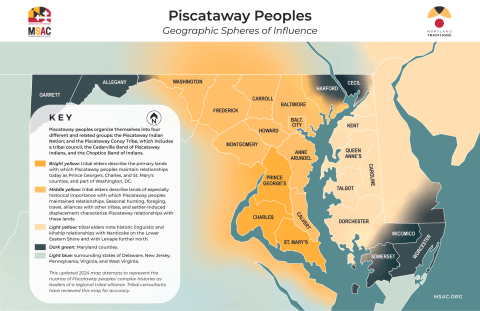
This statement should only be used in connection with lands home to historically erased tribes. It is inappropriate to use this statement to acknowledge tribes that still live in Maryland. See examples of other land acknowledgment statements elsewhere in this document for ways to acknowledge living tribes.
I/we acknowledge that the lands where we gather today were the home of the [tribe name], who were historically erased from this landscape. I/we acknowledge histories of cultural assimilation, land theft, and genocide that caused their decease and erasure. I/we acknowledge their long-standing kinship with these lands and waters and acknowledge that we are uninvited visitors on Indigenous lands. I/we acknowledge the degradation that continues to be wrought on the land and waters in pursuit of resources. I/we acknowledge the right of the land and waterways to heal so that they can continue to provide food and medicine for all. I/we acknowledge that it is our collective obligation to pursue policies and practices that respect the land and waters so that our reciprocal relationship with them can be fully restored. I/we invite you to learn more about historically erased tribes and about land acknowledgment statements via resources available at MSAC.org and elsewhere, to consider donating or making institutional resources available to the tribal peoples who still live in relationship with their traditional lands in the place now known as Maryland, and to reconsider in what ways you can improve your relationship with the lands you steward.
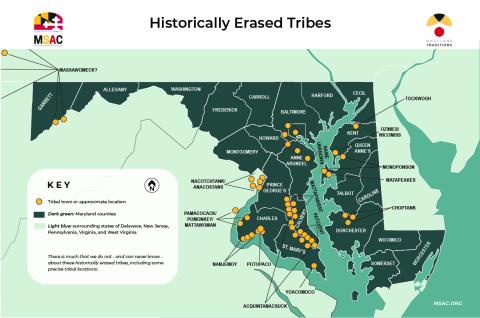
Created by MSAC staff based on information shared by Nause-Waiwash Band of Indians tribal consultants.
I/we acknowledge that the Nause-Waiwash Band of Indians continues to maintain relationships with the lands where we gather today. Descendants of two Nanticoke villages who encountered English explorer John Smith in the 1600s, today the Band actively works to educate the public about their history. Following the seven directions observed by the Band -- North, South, East, West, Up, Down, and Within -- we acknowledge them and their kinship with these lands and waters. I/we acknowledge that we are uninvited visitors on Indigenous lands. To make this statement more meaningful, I/we invite you to learn more about the Nause-Waiwash and about land acknowledgement statements via resources available at msac.org and elsewhere, to consider donating or making institutional resources available to tribal peoples, and to reconsider in what ways you can improve your relationship with the lands you steward.
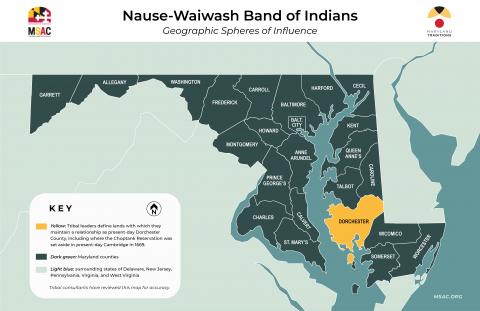
Click here to visit the Nause-Waiwash Band of Indians website.
Created by MSAC staff based on information shared by Piscataway Indian Nation tribal consultants.
I/we acknowledge that the Piscataway Indian Nation continues to maintain a relationship with the lands where we gather today. Along with the Piscataway Conoy Tribe, the Piscataway Indian Nation received recognition by the State of Maryland in 2012. I/we acknowledge their long-standing kinship with these lands and waters and acknowledge that we are uninvited visitors on Indigenous lands. To make this statement more meaningful, I/we invite you to learn more about the Piscataway Indian Nation and about land acknowledgement statements via resources available at msac.org and elsewhere, to consider donating or making institutional resources available to tribal peoples, and to reconsider in what ways you can improve your relationship with the lands you steward.

Created by MSAC staff based on information shared by Pocomoke Indian Nation tribal consultants.
I/we acknowledge that the Pocomoke Indian Nation continues to maintain a relationship with the lands where we gather today. These lands include a series of tribal bands within the Pocomoke Paramountcy: the principal band Pocomoke, and the bands Acquintica, Annemessex, Gingoteague, Manoakin, Morumsco, Nuswattux, and Quindocqua. Beginning in the 1600s, settlers increasingly encroached on these lands and restricted the movements of Pocomoke peoples through land theft and treaty. I/We acknowledge that we are uninvited visitors on Indigenous lands. To make this statement more meaningful, I/we invite you to learn more about the Pocomoke and about land acknowledgement statements via resources available at msac.org and elsewhere, to consider donating or making institutional resources available to tribal peoples, and to reconsider in what ways you can improve your relationship with the lands you steward.
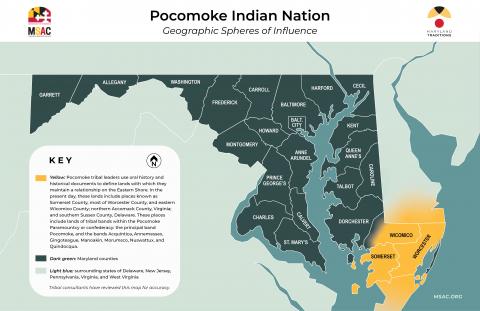
Click here to visit the Pocomoke Indian Nation website.
Based on a land acknowledgment statement drafted by a Susquehanna and Shawnee elder for the MSAC Land Acknowledgment Project.
I/we acknowledge that the places today known as Baltimore County, Harford County, and Cecil County exist as the result of duress. In 1652, Susquehannock leaders unwillingly transferred these lands to the English in an unsuccessful effort to stop English settlers encroaching up the Susquehanna River. I/we acknowledge that these places and their Indigenous inhabitants exist without rigid political borders and boundaries maintained by settlers and settler governments.
I/we acknowledge the social, physical, spiritual, and kinship relationships this land continues to share with Indigenous nations of the Susquehanna River and Chesapeake Bay; I/we acknowledge that these relationships have been displaced, damaged, and dispelled by colonists’ insatiable thirst for acquisition and domination. I/we acknowledge a place out of balance with its true purpose in being. I/we acknowledge our occupation of Susquehannock lands. I/we acknowledge the continuing presence of Indigenous nations, and the shelter and nourishment that this place continues to provide all Native peoples who live here today. I/we acknowledge my/our responsibility to Indigenous nations to repair unhealthy relationships and to steward all life.
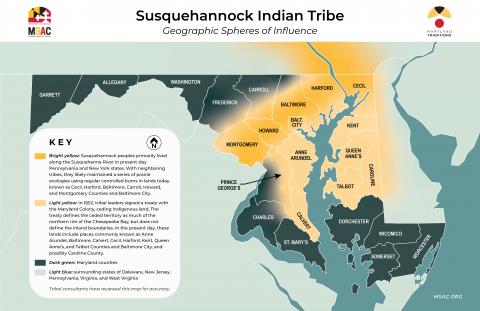
Created by MSAC staff based on information shared by Youghiogheny River Band of Shawnee tribal consultants.
I/we acknowledge that the Youghiogheny River Band of Shawnee continues to maintain relationships with the lands where we gather today. The Youghiogheny River Band of Shawnee has stewarded these lands and waters for generations. Shawnee peoples maintained a nomadic tradition prior to the start of European settlement, regularly renewing relationships with lands across the Eastern Seaboard. The Youghiogheny River Band of Shawnee are still here and share this land with all visitors to it. With them, we uninvited visitors honor these lands, which carry the memory of joys and tears and loss. To make this statement more meaningful, I/we invite you to learn more about the Shawnee and about land acknowledgement statements via resources available at msac.org and elsewhere, to consider donating and making institutional resources available to tribal peoples, and to reconsider in what ways you can improve your relationship with the lands you steward.
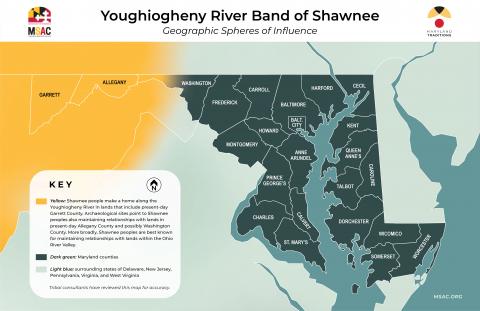
Employees of the State of Maryland serve residents of Maryland who live across many different tribal lands. This statement acknowledges all tribes who maintain relationships with lands claimed by the State of Maryland.
This statement is based on one drafted by an elder of the Choptico Band of Indians, Piscataway-Conoy Tribe for the MSAC Land Acknowledgement Project.
Click here for an audio pronunciation guide.
We acknowledge the lands and waters now known as Maryland are the home of its first peoples: the Accohannock Indian Tribe, Assateague People’s Tribe, Cedarville Band of Piscataway Indians, Choptico Band of Indians, Lenape Tribe, Nanticoke Tribe, Nause-Waiwash Band of Indians, Piscataway Conoy Tribe, Piscataway Indian Nation, Pocomoke Indian Nation, Susquehannock Indians, Youghiogheny River Band of Shawnee, and tribes in the Chesapeake watershed who have seemingly vanished since the coming of colonialism. We acknowledge that this land is now home to other tribal peoples living here in diaspora. We acknowledge the forced removal of many from the lands and waterways that nurtured them as kin. We acknowledge the degradation that continues to be wrought on the land and waters in pursuit of resources. We acknowledge the right of the land and waterways to heal so that they can continue to provide food and medicine for all. We acknowledge that it is our collective obligation to pursue policies and practices that respect the land and waters so that our reciprocal relationship with them can be fully restored.
